Search Result
Results for "
tumour growth
" in MedChemExpress (MCE) Product Catalog:
1
Biochemical Assay Reagents
3
Isotope-Labeled Compounds
| Cat. No. |
Product Name |
Target |
Research Areas |
Chemical Structure |
-
- HY-46568
-
|
|
CDK
|
Cancer
|
|
CDK7/12-IN-1 is a selective CDK7/12 inhibitor with IC50s of 3 and 277 nM for CDK7 and CDK 12, respectively. CDK7 and CDK12 inhibition is an effective strategy to inhibit tumour growth .
|
-
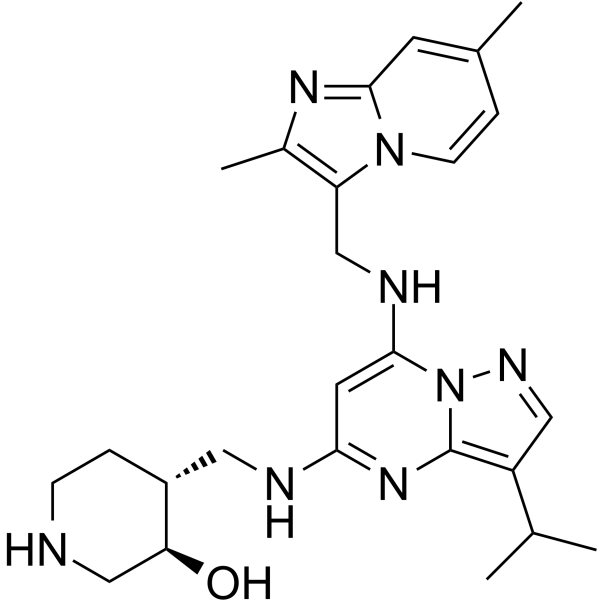
-
- HY-B0448
-
-
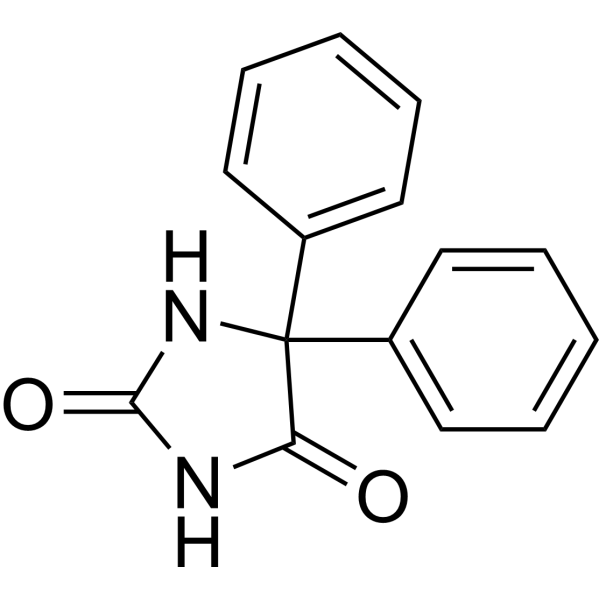
-
- HY-B0448A
-
|
5,5-Diphenylhydantoin sodium salt
|
Sodium Channel
Virus Protease
|
Neurological Disease
Cancer
|
|
Phenytoin sodium (5,5-Diphenylhydantoin sodium salt) is a potent Voltage-gated Na + channels (VGSCs) blocker. Phenytoin has antiepileptic activity and reduces breast tumour growth and metastasis in mice .
|
-
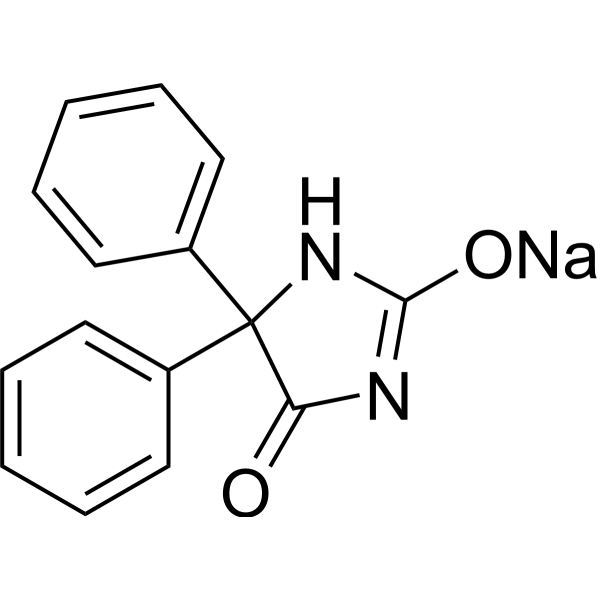
-
- HY-150966
-
|
|
Mitochondrial Metabolism
|
|
|
Antiproliferative agent-10 (compound 8) is an anti-tumour ruthenium(II)-tris-pyrazolylmethane complex that inhibits the growth of cancer cells by inhibiting mitochondrial calcium uptake .
|
-
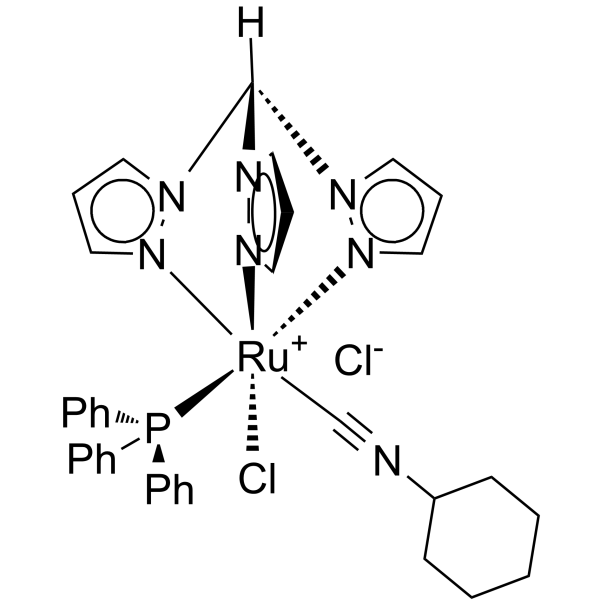
-
- HY-150969
-
|
|
Mitochondrial Metabolism
|
Cancer
|
|
Antiproliferative agent-10 (compound 1) is an anti-tumour ruthenium(II)-tris-pyrazolylmethane complex that inhibits the growth of cancer cells by inhibiting mitochondrial calcium uptake .
|
-
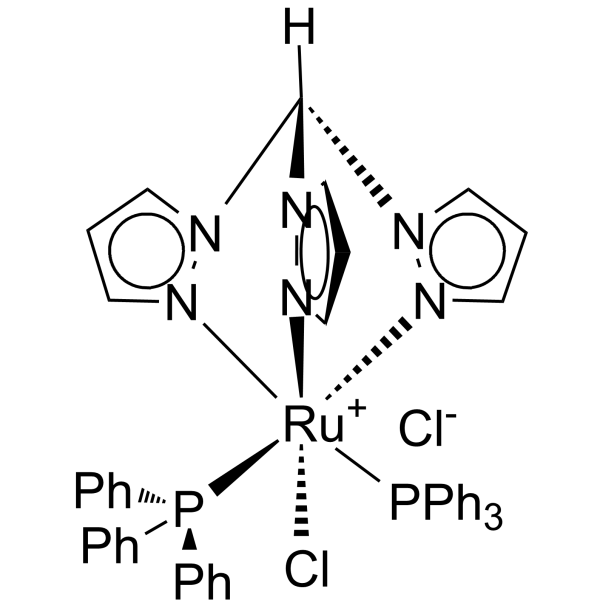
-
- HY-16293
-
|
PM01183; LY-01017
|
DNA Alkylator/Crosslinker
DNA/RNA Synthesis
|
Cancer
|
|
Lurbinectedin (PM01183) is a DNA minor groove covalent binder with potent anti-tumour activity; inhibits RMG1 and RMG2 cell growth with IC50 values of 1.25 and 1.16 nM, respectively.
|
-

-
- HY-103244
-
CITCO
1 Publications Verification
|
Apoptosis
|
Cancer
|
|
CITCO, an imidazothiazole derivative, is a selective Constitutive androstane receptor (CAR) agonist. CITCO inhibits growth and expansion of brain tumour stem cells (BTSCs) and has an EC50 of 49 nM over pregnane X receptor (PXR), and no activity on other nuclear receptors .
|
-

-
- HY-B0448S
-
|
5,5-Diphenylhydantoin-d10
|
Sodium Channel
Virus Protease
|
Neurological Disease
|
|
Phenytoin-d10 is the deuterium labeled Phenytoin. Phenytoin (5,5-Diphenylhydantoin) is a potent Voltage-gated Na+ channels (VGSCs) blocker. Phenytoin has antiepileptic activity and reduces breast tumour growth and metastasis in mice[1][2].
|
-

-
- HY-151101
-
|
|
PROTACs
|
Cancer
|
MS159 is a potent nuclear receptor binding SET structural domain protein 2 (NSD2) PROTACdegrader. MS159 inhibits the growth of tumour cells. MS159 is a useful chemical tool for exploring the role of NSD2 in health and disease .
|
-
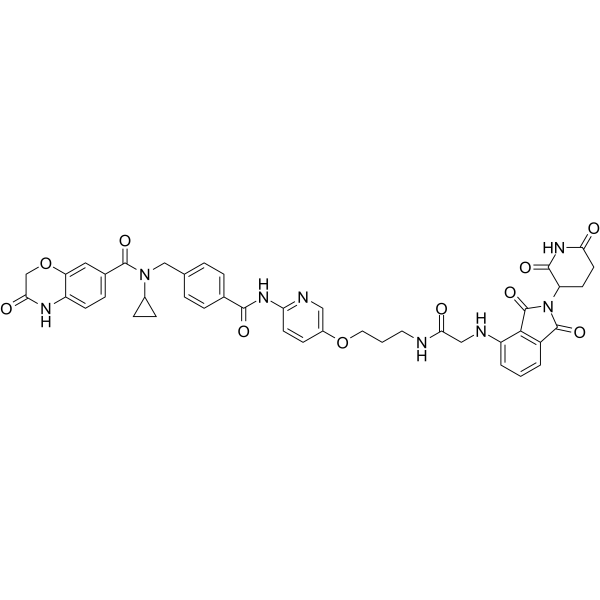
-
- HY-14375
-
|
|
NAMPT
|
Cancer
|
|
CB 300919 is a quinazoline-based antitumour agent with high activity in the CH1 human ovarian tumour xenograft. CB 300919 has a continuous exposure (96 h) growth inhibition IC50 value of 2 nM in human CH1 ovarian tumor xenograft .
|
-

-
- HY-107194
-
|
|
FGFR
|
Cancer
|
|
NSC 12 is an extracellular trap of fibroblast growth factor 2 (FGF2) that binds FGF2 and interferes with its interaction with FGFR1. NSC12 inhibits the proliferation of different FGF-dependent tumour cells both in vitro and in vivo with no systemic toxic effects .
|
-
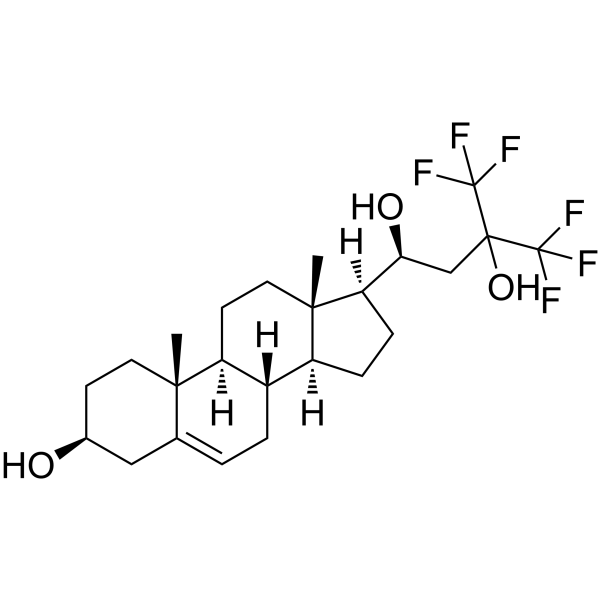
-
- HY-B0448R
-
|
|
Sodium Channel
Virus Protease
|
Neurological Disease
Cancer
|
|
Phenytoin (Standard) is the analytical standard of Phenytoin. This product is intended for research and analytical applications. Phenytoin (5,5-Diphenylhydantoin) is a potent Voltage-gated Na + channels (VGSCs) blocker. Phenytoin has antiepileptic activity and reduces breast tumour growth and metastasis in mice .
|
-

-
- HY-16293S
-
|
PM01183-d3; LY-01017-d3
|
DNA Alkylator/Crosslinker
DNA/RNA Synthesis
|
Cancer
|
|
Lurbinectedin-d3 is deuterium labeled Lurbinectedin. Lurbinectedin (PM01183) is a DNA minor groove covalent binder with potent anti-tumour activity; inhibits RMG1 and RMG2 cell growth with IC50 values of 1.25 and 1.16 nM, respectively[1].
|
-

-
- HY-139109
-
|
ADS 780WS
|
Fluorescent Dye
Apoptosis
|
Others
|
|
IR-783 (ADS 780WS) is a near-infrared (NIR) heptamethine cyanine fluorescent probe. IR-783 significantly inhibits tumour growth and induces apoptosis in MDA-MB-231 xenograft model. IR-783 can be used to study breast cancer .
|
-
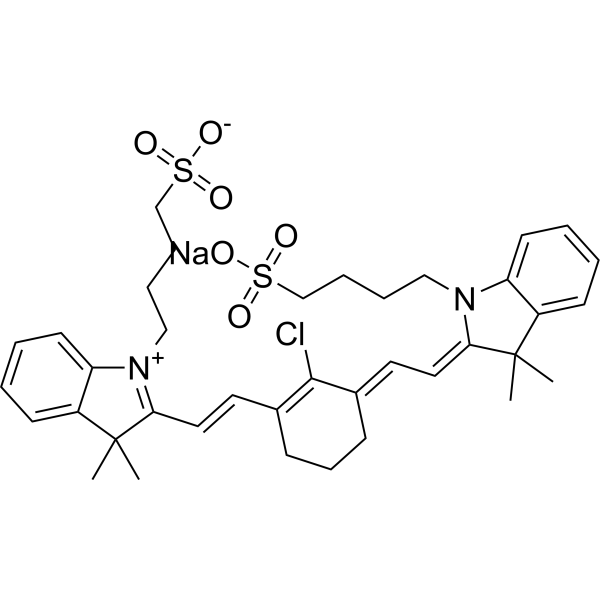
-
- HY-B0448S1
-
|
|
Sodium Channel
Virus Protease
|
|
|
Phenytoin- 15N2, 13C is the 13C and 15N labeled Phenytoin[1]. Phenytoin (5,5-Diphenylhydantoin) is a potent Voltage-gated Na+ channels (VGSCs) blocker. Phenytoin has antiepileptic activity and reduces breast tumour growth and metastasis in mice[2][3].
|
-
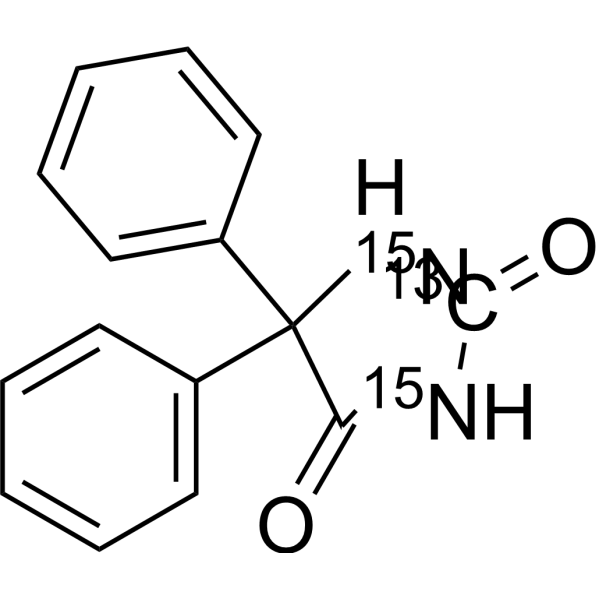
-
- HY-108669
-
|
|
P2X Receptor
|
Neurological Disease
Cancer
|
|
AZ10606120 dihydrochloride is a selective, high affinity antagonist for P2X7 receptor (P2X7R) at human and rat with an IC50 of about 10 nM. AZ10606120 dihydrochloride is little or no effect at other P2XR subtypes. AZ10606120 dihydrochloride has anti-depressant effects and reduces tumour growth .
|
-
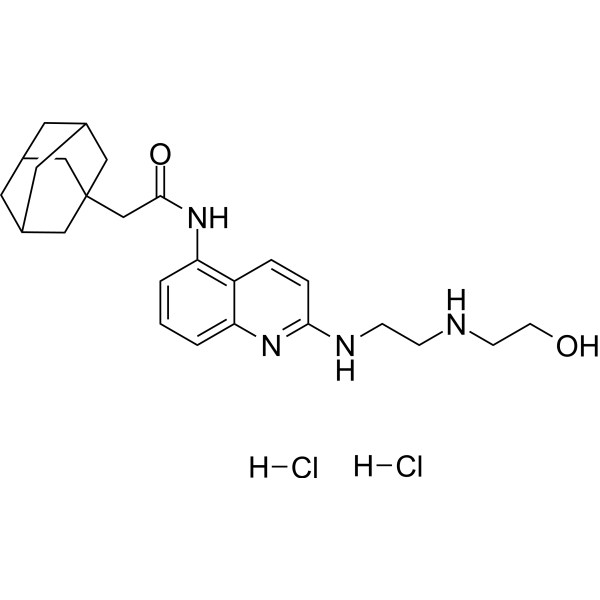
-
- HY-100549
-
|
|
DNA/RNA Synthesis
Apoptosis
|
Cancer
|
|
(S)-Crizotinib is a potent and selective MTH1 (mutT homologue) inhibitor with an IC50 of 330 nM. (S)-Crizotinib disrupts nucleotide pool homeostasis via MTH1 inhibition, induces an increase in DNA single strand breaks, activates DNA repair in human colon carcinoma cells, and effectively suppresses tumour growth in animal models .
|
-
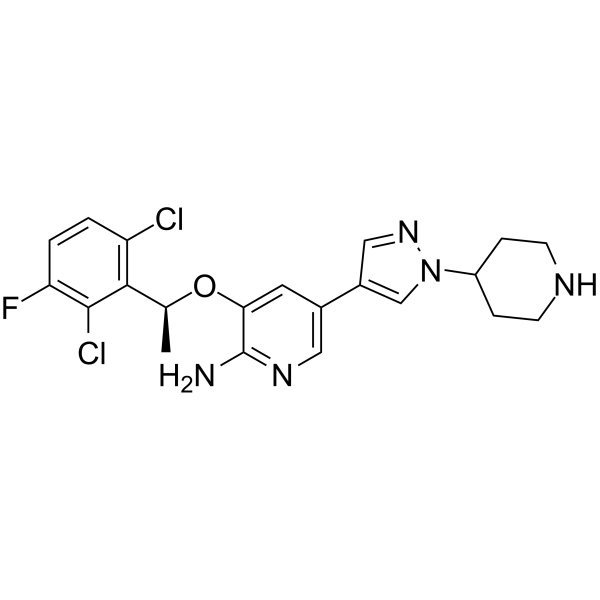
-
- HY-152182
-
ML-SA5
1 Publications Verification
|
TRP Channel
|
Cancer
|
ML-SA5 is a potent TRPML1 cation channel agonist that activates the entire endosomal TRPML1 (ML1) current in DMD myocytes with an EC50 of 285 nM and is more potent than ML-SA1. ML-SA5 has anticancer activity and can inhibit tumour growth .
|
-
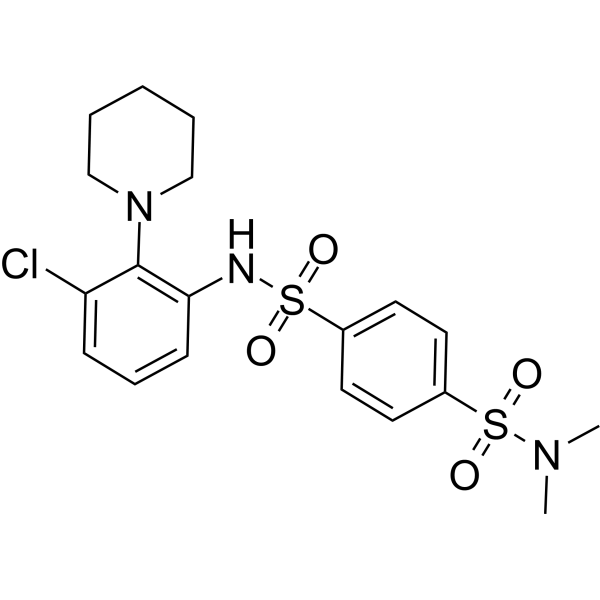
-
- HY-146354
-
|
|
Apoptosis
Reactive Oxygen Species
|
Cancer
|
|
Antiproliferative agent-4 (compound 2y) has excellent anti-proliferative activity against certain cancer cell lines. Antiproliferative agent-4 reduces the mitochondrial membrane potential, and increases the apoptosis rate and the level of ROS on EC109. Antiproliferative agent-4 inhibits tumour growth in nude mice, with low toxicity .
|
-

-
- HY-113604
-
|
|
TGF-β Receptor
|
Cancer
|
Pentabromopseudilin (PBrP) is a marine antibiotic isolated from the marine bacteria Pseudomonas bromoutilis and Alteromonas luteoviolaceus. PBrP exhibits antimicrobial, anti-tumour and phytotoxic activities. PBrP is a reversible and allosteric inhibitor of myosin Va (MyoVa). PBrP also is a potent inhibitor of transforming growth factor-β (TGF-β) activity. PBrP can be used for the research of fibrotic diseases and cancer .
|
-
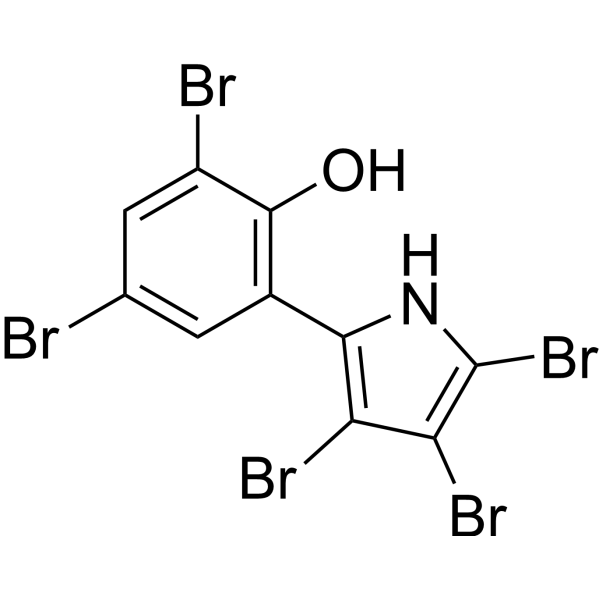
-
- HY-145388
-
|
|
PROTACs
Epigenetic Reader Domain
|
Cancer
|
|
AU-15330 is a proteolysis-targeting chimera (PROTAC) degrader of the SWI/SNF ATPase subunits, SMARCA2 and SMARCA4. AU-15330 induces potent inhibition of tumour growth in xenograft models of prostate cancer and synergizes with the AR antagonist enzalutamide. AU-15330 induces disease remission in castration-resistant prostate cancer (CRPC) models without toxicity .
|
-
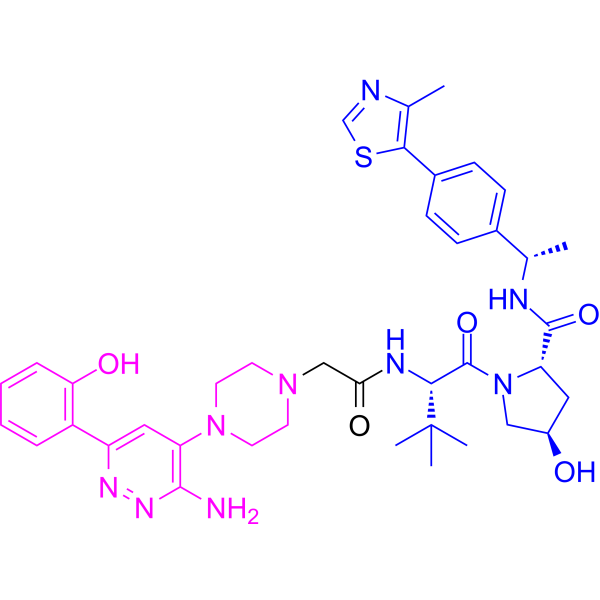
-
- HY-151275
-
|
|
TGF-β Receptor
TGF-beta/Smad
|
Cancer
|
|
ALK5-IN-28 (compound Ex-05) is a selective ALK-5 inhibitor (IC50≤10 nM), inhibits TGF-β-induced SMAD signaling. ALK5-IN-28 has the potential to inhibit growth of tumour in vivo. ALK5-IN-28 can be used in study of proliferative diseases such as cancer, fibrotic diseases, and systemic sclerosis .
|
-
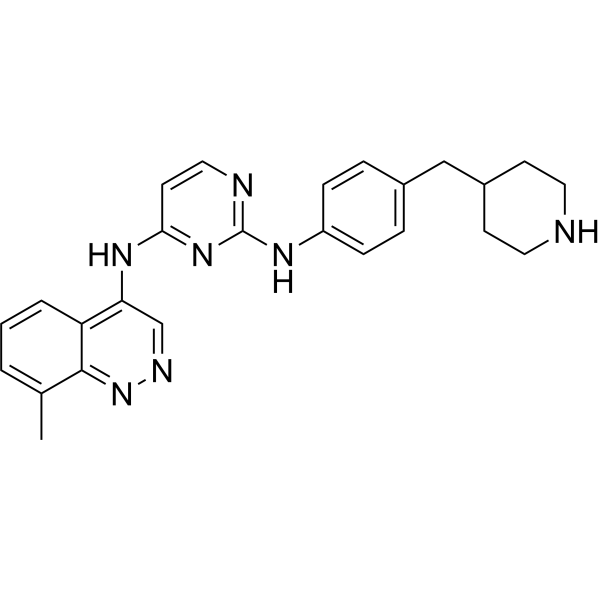
-
- HY-151281
-
|
|
TGF-β Receptor
|
Cancer
|
|
ALK5-IN-31 (compound Ex-08) is a selective ALK-5 inhibitor (IC50≤10 nM), inhibits TGF-β-induced SMAD signaling. ALK5-IN-31 has the potential to inhibit growth of tumour in vivo. ALK5-IN-31 can be used in study of proliferative diseases such as cancer, fibrotic diseases, and systemic sclerosis .
|
-
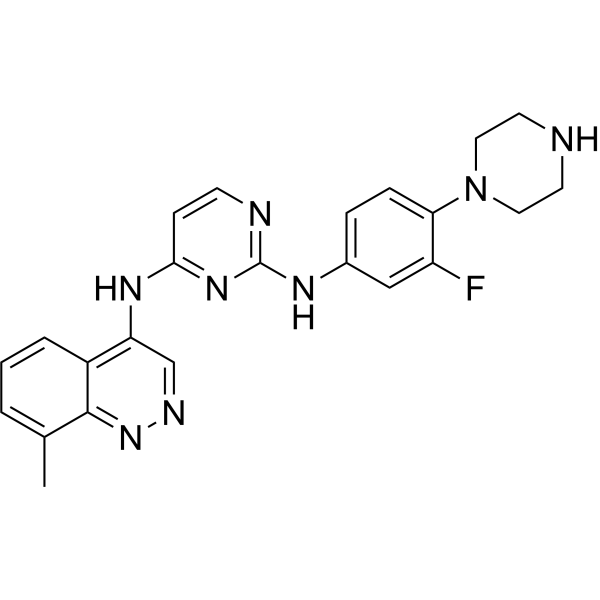
-
- HY-151606
-
|
|
Akt
|
Cancer
|
|
Akt3 degrader 1 (compound 12l) is a selective Akt3 degrader that overcomes Osimertinib (HY-15772)-induced resistance in H1975OR NSCLC cells. Akt3 degrader 1 also has anti-proliferative activity and significantly inhibits tumour growth in mice. Akt3 degrader 1 can be used in the study of drug-resistant non-small cell lung cancer .
|
-
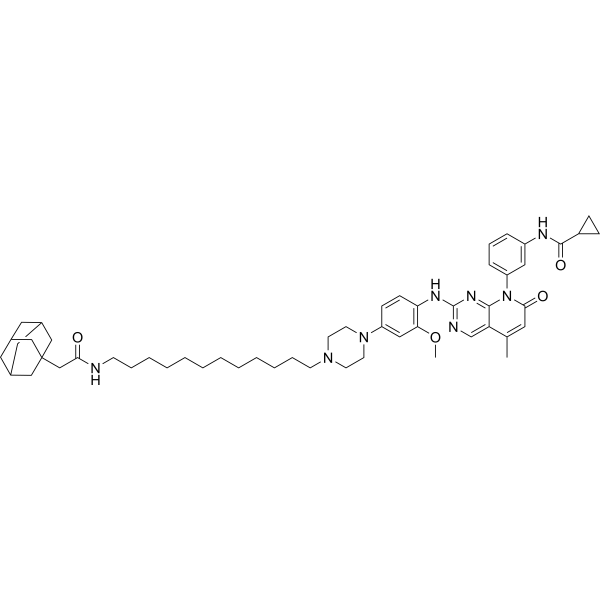
-
- HY-151282
-
|
|
TGF-β Receptor
TGF-beta/Smad
|
Cancer
|
|
ALK5-IN-32 (compound EX-09) is a selective ALK-5 inhibitor (10 nM<IC50<100 nM), inhibits TGF-β-induced SMAD signaling. ALK5-IN-32 has the potential to inhibit growth of tumour in vivo. ALK5-IN-32 can be used in study of proliferative diseases such as cancer, fibrotic diseases, and systemic sclerosis .
|
-
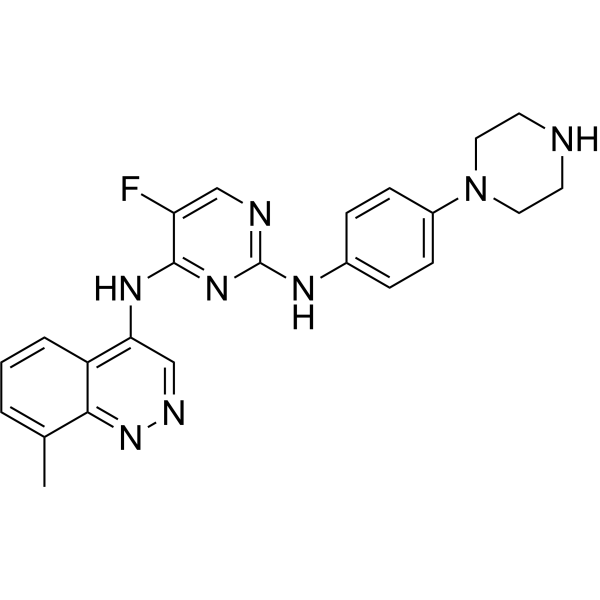
-
- HY-13545
-
|
|
Apoptosis
|
Inflammation/Immunology
Cancer
|
|
ABT-510 is an anti-angiogenic TSP peptide (Thrombospondin-1 analogue) that induces apoptosis and inhibits ovarian tumour growth in an orthotopic, syngeneic model of epithelial ovarian cancer. ABT-510 also reduces angiogenesis and inflammatory responses in a murine model of inflammatory bowel disease. ABT-510 can be used in studies of cancer (particularly epithelial ovarian cancer) and inflammatory bowel disease (IBD) .
|
-
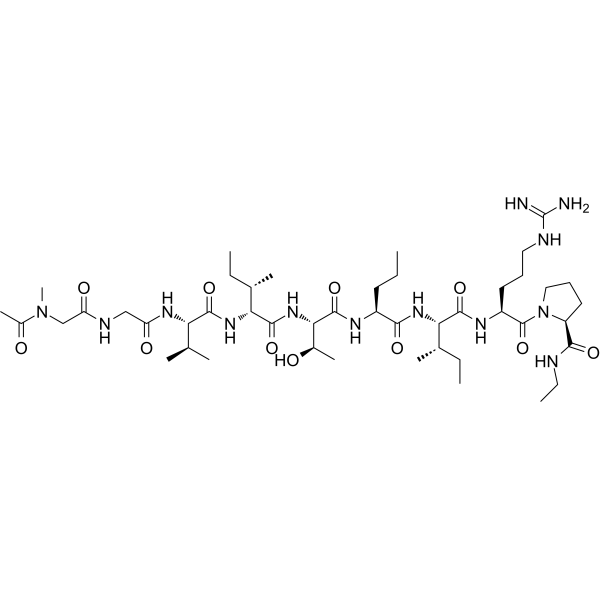
-
- HY-13545B
-
|
|
Apoptosis
|
Inflammation/Immunology
Cancer
|
|
ABT-510 acetate is an anti-angiogenic TSP peptide (Thrombospondin-1 analogue) that induces apoptosis and inhibits ovarian tumour growth in an orthotopic, syngeneic model of epithelial ovarian cancer. ABT-510 acetate also reduces angiogenesis and inflammatory responses in a murine model of inflammatory bowel disease. ABT-510 acetate can be used in studies of cancer (particularly epithelial ovarian cancer) and inflammatory bowel disease (IBD) .
|
-
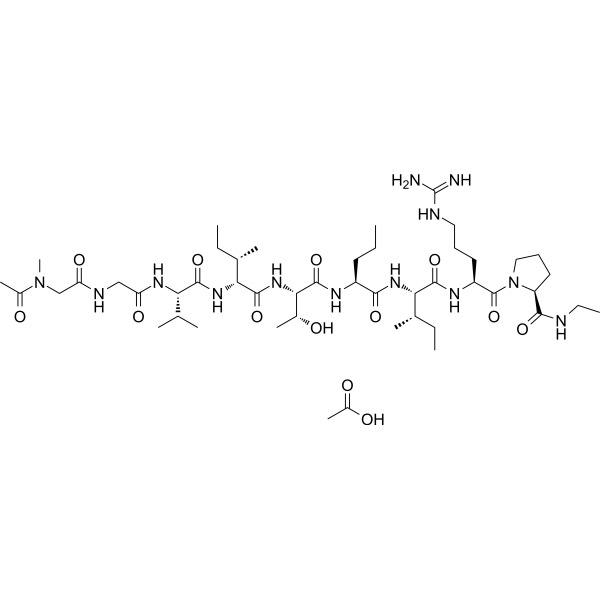
-
- HY-18684
-
|
5'-Isobutylthioadenosine; 5'-Deoxy-5'-isobutylthioadenosine
|
Nucleoside Antimetabolite/Analog
HSV
Parasite
|
Infection
Metabolic Disease
Cancer
|
|
SIBA (5'-Isobutylthioadenosine) is a transmethylation inhibitor (SAH (HY-19528) analogue), with potent anti-proliferative activity. SIBA reversibly inhibits the production of HSV-1 by blocking methylation, specifically by blocking the 5' end-capping of viral mRNA. SIBA also inhibits the growth of tumour cells in vitro and metastatic spread in vivo. SIBA can be used in cancer, HSV-1 infection and anti-malaria studies .
|
-
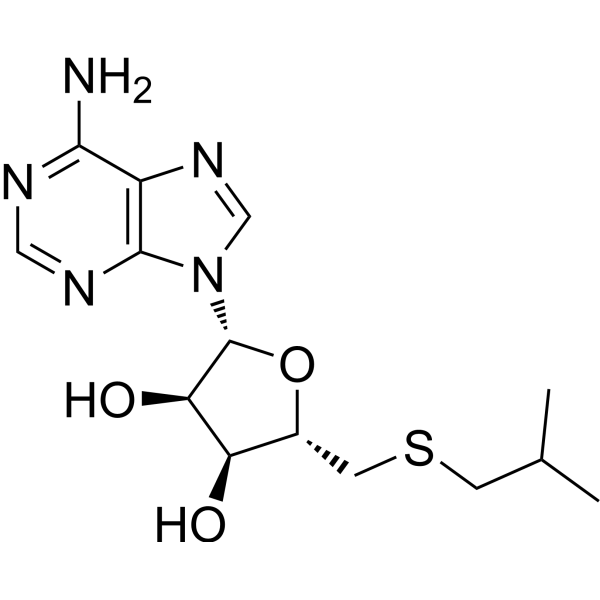
-
- HY-142076
-
|
|
CDK
|
Cancer
|
|
CDK4/6-IN-15 is an orally active and selective CDK4/6 inhibitor. CDK4/6-IN-15 potently inhibits cancer cells growth. CDK4/6-IN-15 arrests cell cycle at G1 phase and suppresses retinoblastoma tumour suppressor protein (Rb) phosphorylation at S780 and E2 factor (E2F)-regulated gene expression .
|
-

-
- HY-124727
-
|
|
JAK
Apoptosis
|
Cancer
|
|
ZT55 is an orally active and highly-selective JAK2 inhibitor with an IC50 value of 0.031 μM. ZT55 inhibits the proliferation of JAK2 V617F-expressing HEL cell lines and induces apoptosis and cycle arrest. ZT-55 also effectively inhibits the growth of HEL xenograft tumours in a mice model. ZT-55 can be used in studies of myeloproliferative neoplasms, polycythemia vera and primary thrombocythemia .
|
-

-
- HY-150562
-
|
|
CDK
|
Cancer
|
|
CDK9-IN-19 is a highly potent and selective CDK9 inhibitor with an IC50 value of 2.0 nM. CDK9-IN-19 has excellent cellular antiproliferative activity, moderate pharmacokinetic property and low hERG inhibition. CDK9-IN-19 significantly induces tumour growth inhibition in an MV4-11 xenograft mice model. CDK9-IN-19 can be used for researching acute myeloid leukaemia (AML) .
|
-
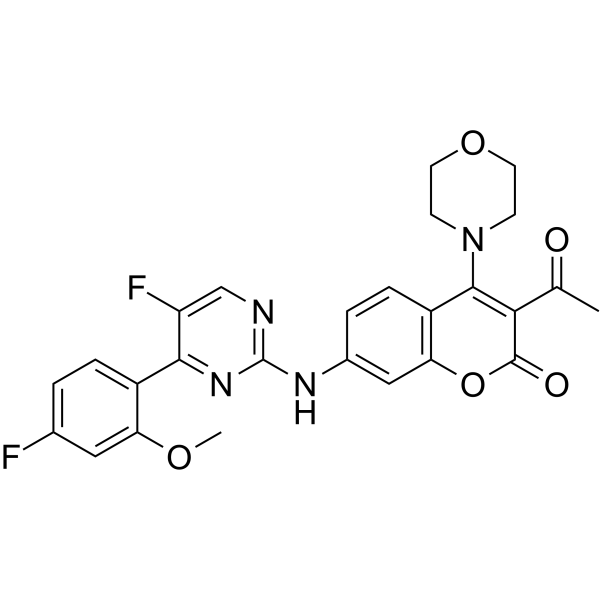
-
- HY-119944
-
|
|
EGFR
|
Cancer
|
|
JND3229 is a reversible EGFR C797S inhibitor with IC50 values of 5.8, 6.8 and 30.5 nM for EGFR L858R/T790M/C797S, EGFR WT and EGFR L858R/T790M, respectively. JND3229 has good anti-proliferative activity and can effectively inhibit tumour growth in vivo. JND3229 can be used in cancer research, especially in non-small cell carcinoma .
|
-

-
- HY-120213
-
|
|
FAK
Src
PI3K
MMP
Apoptosis
|
Cancer
|
|
YH-306 is an antitumor agent. YH-306 suppresses colorectal tumour growth and metastasis via FAK pathway. YH-306 significantly inhibits the migration and invasion of colorectal cancer cells. YH-306 potently suppresses uninhibited proliferation and induces cell apoptosis. YH-306 suppresses the activation of FAK, c-Src, paxillin, and PI3K, Rac1 and the expression of MMP2 and MMP9. YH-306 also inhibita actin-related protein (Arp2/3) complex-mediated actin polymerization .
|
-

| Cat. No. |
Product Name |
Type |
-
- HY-139109
-
|
ADS 780WS
|
Biochemical Assay Reagents
|
|
IR-783 (ADS 780WS) is a near-infrared (NIR) heptamethine cyanine fluorescent probe. IR-783 significantly inhibits tumour growth and induces apoptosis in MDA-MB-231 xenograft model. IR-783 can be used to study breast cancer .
|
| Cat. No. |
Product Name |
Target |
Research Area |
-
- HY-13545B
-
|
|
Apoptosis
|
Inflammation/Immunology
Cancer
|
|
ABT-510 acetate is an anti-angiogenic TSP peptide (Thrombospondin-1 analogue) that induces apoptosis and inhibits ovarian tumour growth in an orthotopic, syngeneic model of epithelial ovarian cancer. ABT-510 acetate also reduces angiogenesis and inflammatory responses in a murine model of inflammatory bowel disease. ABT-510 acetate can be used in studies of cancer (particularly epithelial ovarian cancer) and inflammatory bowel disease (IBD) .
|
-
- HY-P0132
-
|
Laminin Fragment 929-933
|
Peptides
|
Cancer
|
|
YIGSR is a peptide that can inhibit the tumour growth and metastasis of leukaemic cells .
|
-
- HY-13545
-
|
|
Apoptosis
|
Inflammation/Immunology
Cancer
|
|
ABT-510 is an anti-angiogenic TSP peptide (Thrombospondin-1 analogue) that induces apoptosis and inhibits ovarian tumour growth in an orthotopic, syngeneic model of epithelial ovarian cancer. ABT-510 also reduces angiogenesis and inflammatory responses in a murine model of inflammatory bowel disease. ABT-510 can be used in studies of cancer (particularly epithelial ovarian cancer) and inflammatory bowel disease (IBD) .
|
| Cat. No. |
Product Name |
Target |
Research Area |
-
- HY-P99160
-
|
|
Inhibitory Antibodies
|
Cancer
|
|
Labetuzumab is a humanised anti-carcinoembryonic antigen (CEA) monoclonal antibody that inhibits tumour growth and sensitises human medullary thyroid cancer xenografts to Dacarbazine chemotherapy .
|
-
- HY-P99176
-
ATG-031
1 Publications Verification
|
Inhibitory Antibodies
|
Cancer
|
|
ATG-031 is a humanised anti-CD24 monoclonal antibody. ATG-031 effectively stimulates macrophage-mediated phagocytosis and induces cancer cell destruction by blocking the "don't eat me" signals that characterize the growth of many cancers. ATG-031 can be used in the study of haematological malignancies as well as solid tumours.
|
| Cat. No. |
Product Name |
Category |
Target |
Chemical Structure |
| Cat. No. |
Product Name |
Chemical Structure |
-
- HY-B0448S
-
|
|
|
Phenytoin-d10 is the deuterium labeled Phenytoin. Phenytoin (5,5-Diphenylhydantoin) is a potent Voltage-gated Na+ channels (VGSCs) blocker. Phenytoin has antiepileptic activity and reduces breast tumour growth and metastasis in mice[1][2].
|
-

-
- HY-16293S
-
|
|
|
Lurbinectedin-d3 is deuterium labeled Lurbinectedin. Lurbinectedin (PM01183) is a DNA minor groove covalent binder with potent anti-tumour activity; inhibits RMG1 and RMG2 cell growth with IC50 values of 1.25 and 1.16 nM, respectively[1].
|
-

-
- HY-B0448S1
-
|
|
|
Phenytoin- 15N2, 13C is the 13C and 15N labeled Phenytoin[1]. Phenytoin (5,5-Diphenylhydantoin) is a potent Voltage-gated Na+ channels (VGSCs) blocker. Phenytoin has antiepileptic activity and reduces breast tumour growth and metastasis in mice[2][3].
|
-

Your information is safe with us. * Required Fields.
Inquiry Information
- Product Name:
- Cat. No.:
- Quantity:
- MCE Japan Authorized Agent:









































